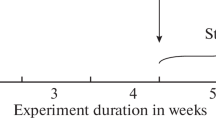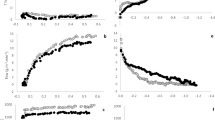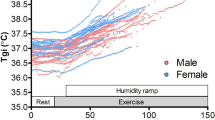Summary
Body temperature regulation was studied in 6 male subjects during an acclimation procedure involving uninterrupted heat exposure for 5 successive days and nights in a hot dry environment (ambient temperature =35° C, dew-point temperature =7° C; air velocity = 0.2 m·s−1). Data were obtained at rest and during exercise (relative mechanical workload =35% \(\dot V_{{\text{O}}_{{\text{2 max}}} } \)). At rest, hourly measurements were made of oesophageal and 4 local skin temperatures, to allow the calculation of mean skin temperature, and of body motility and heart rate. During the working periods these measurements were made at 5 min intervals. Hourly whole-body weight loss was measured at rest on a sensitive platform scale while in the working condition just before starting and immediately after completing the bicycle exercise. The results show that, in both exercise and at rest, the successive heat exposures increased the sweat gland output during the first 3 days. Afterwards, sweat rate decreased without any corresponding change, in body temperature. For the fixed workload, the sweat rate decline was associated with a decrease in circulatory strain. Adjustments in both sweating and circulatory mechanisms occur in the first 3 days of continuous heat exposure. The overall sweat rate decline could involve a redistribution of the regional sweating rates which enhances the sweat gland activities of skin areas with maximal evaporative efficiencies.
Similar content being viewed by others
References
Bass DE, Kleeman CR, Quinn M, Henschel A, Hegnauer H (1955) Mechanisms of acclimatization to heat in man. Medicine 34:323–380
Belding HS, Hatch TF (1963) Relation of skin temperature to acclimation and tolerance to heat. Fed Proc 22:881–883
Borbély AA, Neuhauss HU, Mattmann P, Waser PG (1981) Langzeitregistrierung der Bewegungsaktivität: Anwendungen in Forschung und Clinik. Schweiz Med Wochenschr 111:730–735
Bortner RW (1969) A short rating scale as a potential measure of pattern A behavior. J Chron Dis 22:86–91
Eysenck MJ, Eysenck SB (1971) Inventaire de personnalité d'Eysenck (E.P.I.). Traduction et adaptation par Ganansia K, Editions du Centre de Psychologie Appliquée, Paris
Fox RH, Goldsmith R, Hampton LFG, Lewis HE (1964) The nature of the increase in sweating capacity produced by heat acclimatization. J Physiol 171:368–376
Gerking SD, Robinson S (1946) Decline in the rates of sweating of men working in severe heat. Am J Physiol 147:370–378
Hénane R, Valatx JL (1973) Thermoregulatory changes induced during heat acclimatization by controlled hyperthermia in man. J Physiol 230:255–271
Hellon RF, Jones JM, MacPherson RK, Weiner DS (1956) Natural and artificial acclimatization to hot environments. J Physiol 132:559–576
Höfler W (1968) Changes in regional distribution of sweating during acclimation to heat. J Appl Physiol 25:503–506
Horne JA, Ostberg O (1976) A self-assessment questionnaire to determine morningness-eveningness in human circadian rhythm. Int J Chronobiol 4:97–110
Ladell WSS (1951) Assessment of group acclimation to heat and humidity. J Physiol 115:296–312
Ladell WSS (1964) Terrestrial animals in humid heat: man. In: Dill DB, Adolph EF, Wilber GG (eds) Handbook of physiol adaptation to the environment. Am Physiol Soc, Washington, pp 625–679
Libert JP, Candas V, Vogt JJ (1983) Modifications of sweating responses to thermal transients following heat acclimation. Eur J Appl Physiol 50:235–246
Lind AR, Bass DE (1963) Optimal exposure time for development of acclimatization to heat. Fed Proc 22:704–708
Nishi Y, Gagge AP (1970) Direct evaluation of convective heat transfer coefficient by naphtalene sublimation. J Appl Physiol 29:830–838
Ramanathan NL (1964) A new weighting system for mean surface temperature of the human body. J Appl Physiol 19:531–533
Raynaud J, Martineaud JP, Durand J (1979) Body temperatures and chronic heat exposure. In: Durand J, Raynaud J (eds) Thermal comfort: physiological and psychological bases. INSERM, Paris, pp 345–365
Robinson S (1968) Physiological adjustments to heat. In: Physiology of Heat Regulation and The Science of Clothing. Newburgh LH (ed) Hafner Publ Comp, New-York, London: 193–231
Sargent F (1962) Depression of sweating in man: so-called sweat gland fatigue. In: Montagna W, Ellis RA, Silver AI (eds) Advances in biology of skin. Pergamon, London, 3:163–212
Wyndham CH, Bouwer WV, Devine MG, Paterson HE (1952) Physiological responses of African labourers at various saturated air temperatures, wind velocities and rates of energy expenditure. J Appl Physiol 5:290–298
Wyndham CH (1967) Effect of acclimation on the sweat rate/rectal temperature relationship. J Appl Physiol 22:27–30
Author information
Authors and Affiliations
Rights and permissions
About this article
Cite this article
Libert, J.P., Amoros, C., Di Nisi, J. et al. Thermoregulatory adjustments during continuous heat exposure. Europ. J. Appl. Physiol. 57, 499–506 (1988). https://doi.org/10.1007/BF00417999
Accepted:
Issue Date:
DOI: https://doi.org/10.1007/BF00417999




